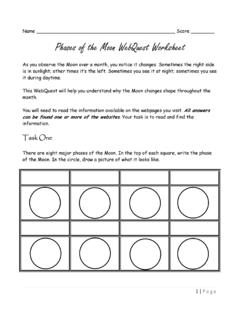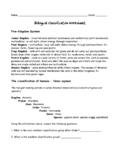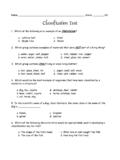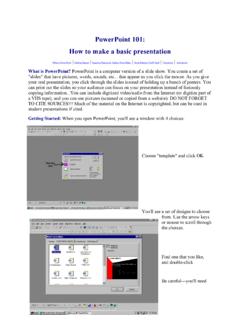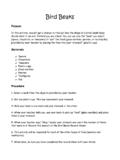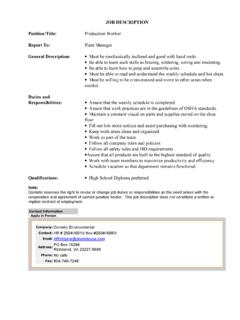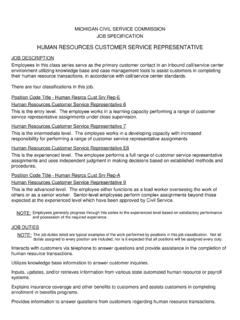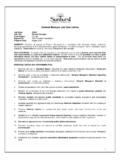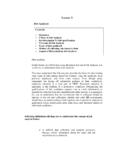Transcription of Comparing the Cell to a Factory - Mr. Hill's Science …
1 Comparing the Cell to a Factory (modified from A Busy Factory , ) Imagine a busy Factory making the latest must-have toy. Whether they make bicycles, cell phones, or hot air balloons, most factories are set up the same way. All factories have outside walls that protect and support them and inside walls that create different work areas. They usually have a production line where a product is put together and an executive department that decides what product is made. A finishing department processes and prepares the product for shipping, and a packaging department wraps the product. In addition, a Factory has a receiving department that brings in the parts it needs to make its product, a communications department that allows it to contact suppliers, and a power plant that provides the energy it needs to run.
2 Finally, a custodial staff keeps everything clean and in good working order. cells are similar to factories. To stay alive and function properly, cells have a division of labor similar to that found in factories. All eukaryotic cells are composed of a plasma membrane, a nucleus, and cytoplasm. These structures can be compared with a Factory 's departments. The Plasma Membrane What if you needed to find a job in the Factory ? What could you do? If you do not have any manufacturing skills, and you are not management material, you would probably be placed in an entry-level position. Perhaps you'd be assigned to the warehouse. Here, you would be responsible for shipping and receiving. A Factory requires a constant supply of raw materials, as well as a way to send out the finished product. This department is usually located along an outside wall of the Factory .
3 Working here, you would be one of the Factory 's contacts with the outside world. You might take a job as a receptionist and sit at a desk near the front door of the Factory . A phone would allow you to contact anyone else in the building. Also, all incoming and outgoing calls would go through you. As a receptionist, you may speak for the Factory and allow it to communicate with other people and businesses. Maybe you wouldn't want to lift heavy crates in the warehouse or answer phones. Another possibility might be to take a job with the security department. Security personnel are posted at every entrance to the building. You would be responsible for checking ID cards and admitting only those individuals who belong in the Factory . Mail, reception, and security are separate departments in a real Factory .
4 But in a cell, these jobs are all performed by the plasma membrane. The Nucleus In a Factory , the chief executive officer controls everything that happens. What would it be like to have this job in a cell Factory ? You would have your own office (which would be nice) but you would also have many responsibilities. You would need to keep track of all the blueprints kept in your office. And you would tell the workers which products to build and when to build them. The cell Factory contains a large inventory of blueprints dating all the way to its founding. Some of these blueprints are out of date, and some are for parts and products that are no longer made. Part of your job would entail sorting through everything, finding the correct blueprints, copying them, and sending the copies out to the assembly line at the correct time.
5 When the Factory gets too large, it is difficult to run properly; thus, another Factory must be built. To prepare for this, you have to provide the new Factory with its own set of all the blueprints. Sounds a bit daunting? Now you may have a better appreciation for what the nucleus does in the cell. The Cytoplasm The real work of the cell occurs in the cytoplasm, the cell's " Factory floor." The term "cytoplasm" refers to everything between the cell membrane and the nuclear membrane. It consists mostly of water, salts, some proteins, and many small structures called organelles (or little organs). These structures perform several different functions for the cell which generally fall under the categories of production, maintenance, and energy transformation. This tour of the cell includes several stops on the " Factory floor.
6 " Let's start with the production team. The Endoplasmic Reticulum In a Factory , the assembly of parts takes place on the Factory floor. The highly skilled craftspeople who assemble these components sit hour after hour at their stations, plugging away at their work. These workers are highly paid because they can read plans and use that information to make different kinds of products. Each one of them has his or her own work area, surrounded by tools. These workers do not create the product designs; rather, they read the plans sent from the executive department. The cell has its own assembly line and workers. Within the cytoplasm is a series of large, flattened membranes that fold back and forth on each other and have a very large surface area. This collection of membranes is called the ENDOPLASMIC RETICULUM, or ER the cell s assembly line.
7 The ER stretches from the nuclear membrane to the plasma membrane. It serves as a pathway through the cytoplasm, as a support structure for the attachment of other organelles, and as a workstation for the ribosomes. The ER can be divided into two parts: the rough ER and the smooth ER. The rough ER has ribosomes attached to it and provides a surface along which the process of protein assembly can occur. The smooth ER does not have ribosomes and is much more tubular in appearance. In some human cells , the smooth ER produces steroids; in others it regulates calcium levels. In a process that scientists still don't understand, the rough ER manufactures the membranes of the smooth ER. The Ribosomes Ribosomes, the Factory workers that build proteins, are manufactured by the nucleolus. They consist of two separate subunits: a large, lower subunit and a small, upper subunit.
8 Ribosomes attach to the rough ER. Now let's take a look at how final processing occurs. The Golgi Apparatus What happens to all the products that are built on the assembly line of a Factory ? The final touches are put on them in the finishing and packing department. Workers in this part of the plant are responsible for making minor adjustments to the finished products. They inspect the products for flaws; clean them of any extra material added during their manufacture, wrap them, and target them for packing. The Golgi apparatus performs all the finishing and packing in the cell. Lysosomes and The Cytoskeleton Any Factory needs a good maintenance crew to keep everything orderly, to get rid of the trash, and to take apart and throw away old machinery. The maintenance crew also functions as a second line of defense.
9 If someone gets past the security guard at the front door, it is usually the maintenance crew who catches the trespassers and chases them out. In a cell, the role of building maintenance crew is filled by the lysosomes. Lysosomes The word "lysosome" is Latin for "kill body." This is a very colorful description for some of the most unusual organelles in the cell. LYSOSOMES are organelles produced by the Golgi apparatus that contain powerful protein digesting enzymes. Maintenance crews do not get the glory of chief executive officers, or even that of the production worker, but they serve a very important purpose. Without lysosomes, the cell would accumulate too much junk and would not be able to function for very long. Support Beams There is another major department in a cell Factory , although it usually isn't given a department name in a regular Factory .
10 It's the walls, floors, and ceilings of a Factory . Within the cytoplasm of the cell are many protein fibers that act as support structures. In a cell, the cytoskeleton supports the cell. Mitochondria and Chloroplasts Any Factory needs power to operate. The power must be in a usable form. Most factories have power plants in which generators burn fuel to produce heat. This heat energy is used to make steam, which is then used to make electricity. Building proteins is the main function of cells . But for this to occur, a cell must have an energy source, and that energy must be in a form that the cell can use. The mitochondrion and the chloroplast are the two organelles responsible for energy transformation (neither organelle truly produces energy). Like our Factory 's power plant, mitochondria and chloroplasts transform one form of energy to another.
